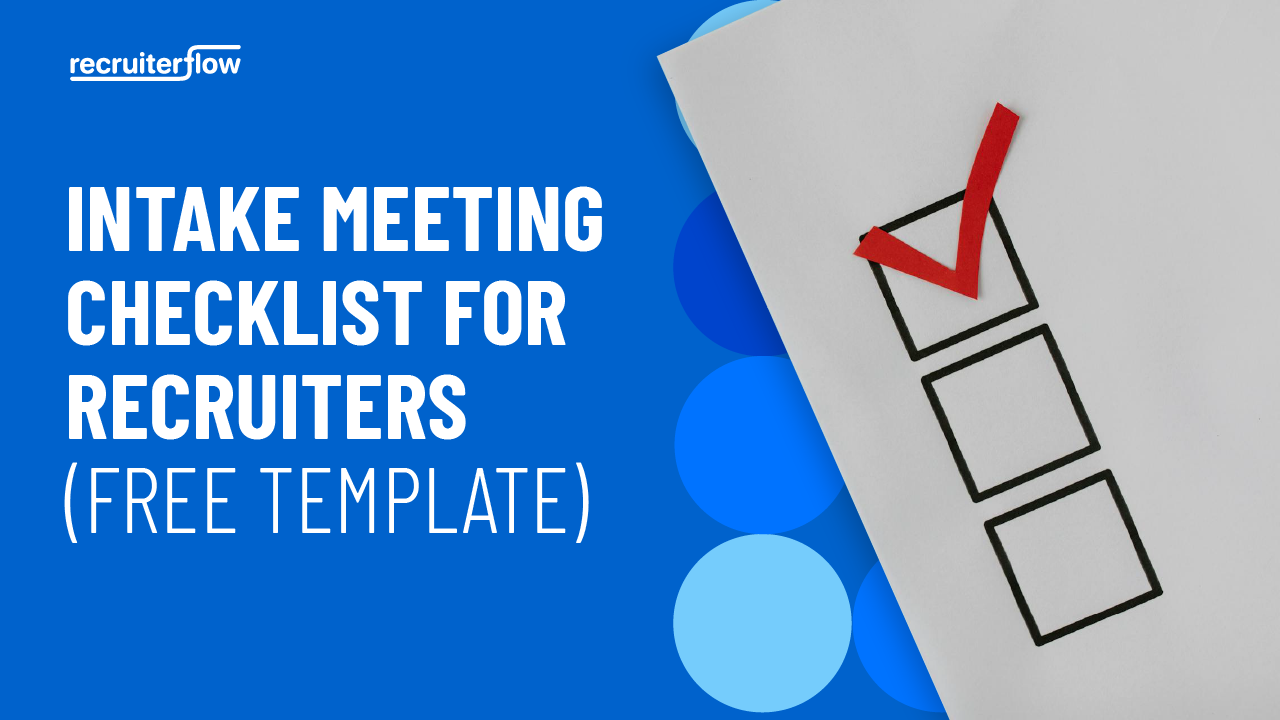
Guide to Social Media Recruiting
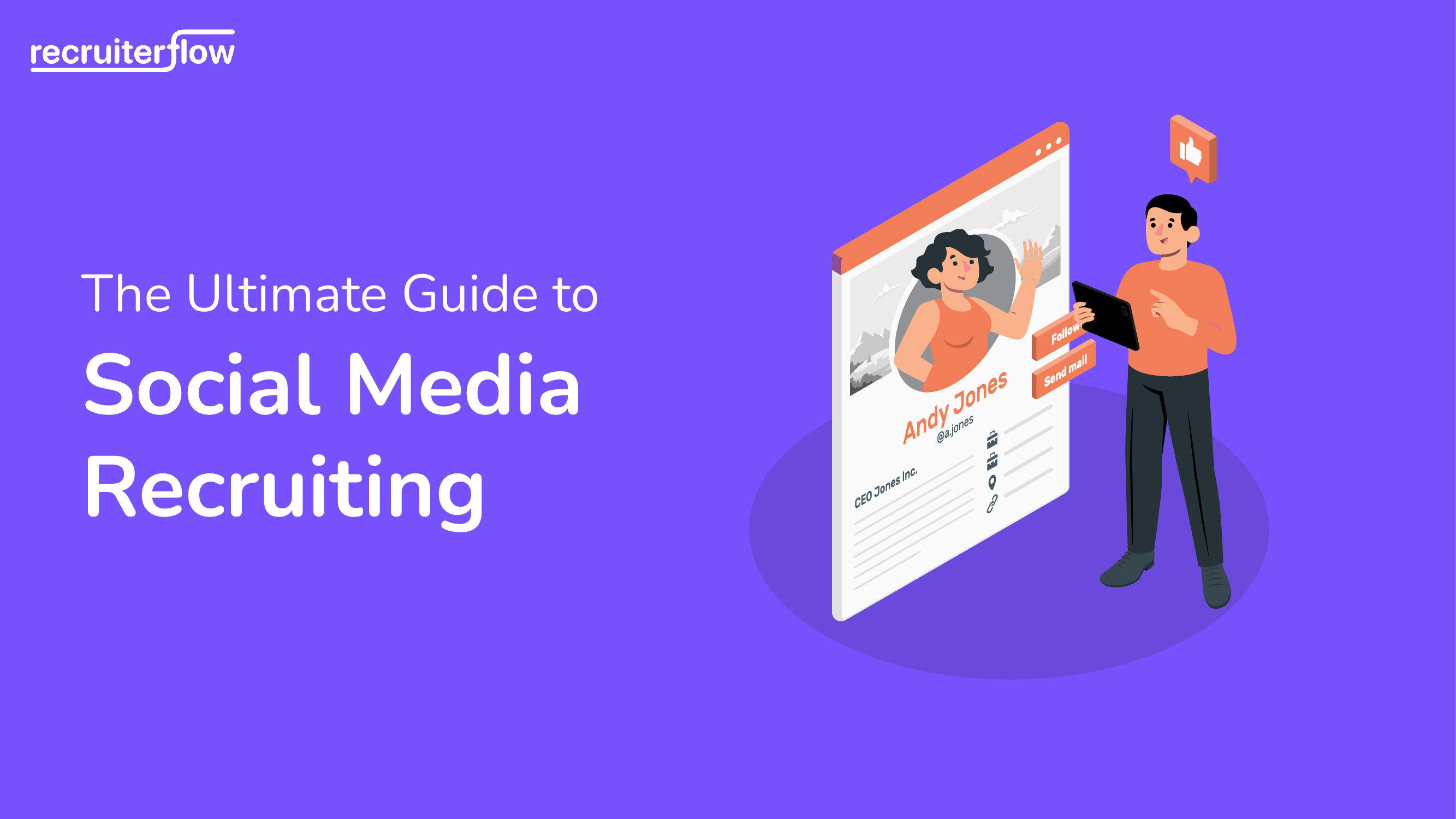
With over 5.16 billion active social media users worldwide, integrating social media into your recruitment strategy is no longer optional– it’s essential.
But how to leverage social media to attract the right candidates efficiently?
In this blog, we’ll break down social media recruiting into three critical steps: understanding what it is, why it works, and how to implement it.
What is social media recruiting?
Social media recruiting uses platforms like LinkedIn, Twitter, Facebook, and Instagram to find, attract, and engage potential candidates to fill the roles.
While traditional job boards still hold importance in the hiring process, 59% of recruiters said prospects found on social media were of the highest quality.
Why you should use social media for recruiting
Social media doesn’t give you access to only active candidates but lets you tap into the passive candidates too. According to a report, around 73% of candidates are passive job seekers. The odds of them running into your listing are higher on social media than on some job boards. Some other benefits include –
Enhance job visibility
With over a billion users on LinkedIn, more than 2 billion on Instagram, and over 500 million on X (formerly Twitter), your job listings can gain significant exposure.
Social media Platforms like LinkedIn are specifically designed for professional networking, making it easier to showcase job opportunities to a targeted audience. By sharing job posts on these platforms, you can increase engagement and attract more applicants.
Find qualified candidates
A report from Zippia found that 84% of companies use social media for recruiting. This comes as no surprise, as the same report also states that almost 80% of job seekers use social media to search for jobs. With most candidates considering social media as a reliable source for finding a new job, it won’t be a miracle if your next candidate could be browsing there right now.
Improve brand awareness
As per a LinkedIn study, 75% of candidates research the organization before they apply for a job and 62% of candidates use social media to gauge an employer’s branding. Social media platforms are a great place to run effective recruitment campaigns that can boost the agency’s brand.
Save time
Social media recruiting offers a quick and efficient way for recruiters to connect with candidates. Communication is more streamlined with features like direct messaging and options to engage directly in comments.
Additionally, with advanced search filters, AI messaging, and ATS integration availability on platforms like LinkedIn, data gathering and screening are also more efficient. Recruiters can quickly schedule interviews and move things forward– reducing overall time to fill positions
Cost-effective solution
Compared to many job boards that can seem costly for small-sized agencies, social media serves as a more viable alternative. With organic posting that comes at no cost and boosting features that start at as low as $2, social media recruitment can reduce the overall recruitment cost.
And with AI tools for social media, recruitment businesses now have assistance for everything from brainstorming ideas and writing content, to automation and AI content distribution. Combining all of this with the data-driven insights that social media analytics tools provide, reviewing and optimizing recruitment strategies has become much easier. These tools help businesses make quicker decisions, manage their budgets more efficiently, and refine their social media recruiting efforts.
Creative job descriptions
Social media job posting allows recruiting agencies to move beyond basic text-based job ads. You can create short-form videos on TikTok, infographics on Instagram, or showcase the client’s company culture with a cool and catchy behind-the-scenes video on YouTube to create good video intros.
Having said that, the basics still need to be strong. If a catchy piece of content leads to a poorly written job description, the listing can take a hit. Want to craft good ones? Use our job description templates.
Wondering how to put these advantages to your agency’s benefit? To get the best out of your social media recruitment efforts, you need to create a framework.
Also, read our blog on How to Hire a Recruiter for recruiting and staffing agencies
How to use social media for recruitment
Here’s an example with steps in social media recruiting:
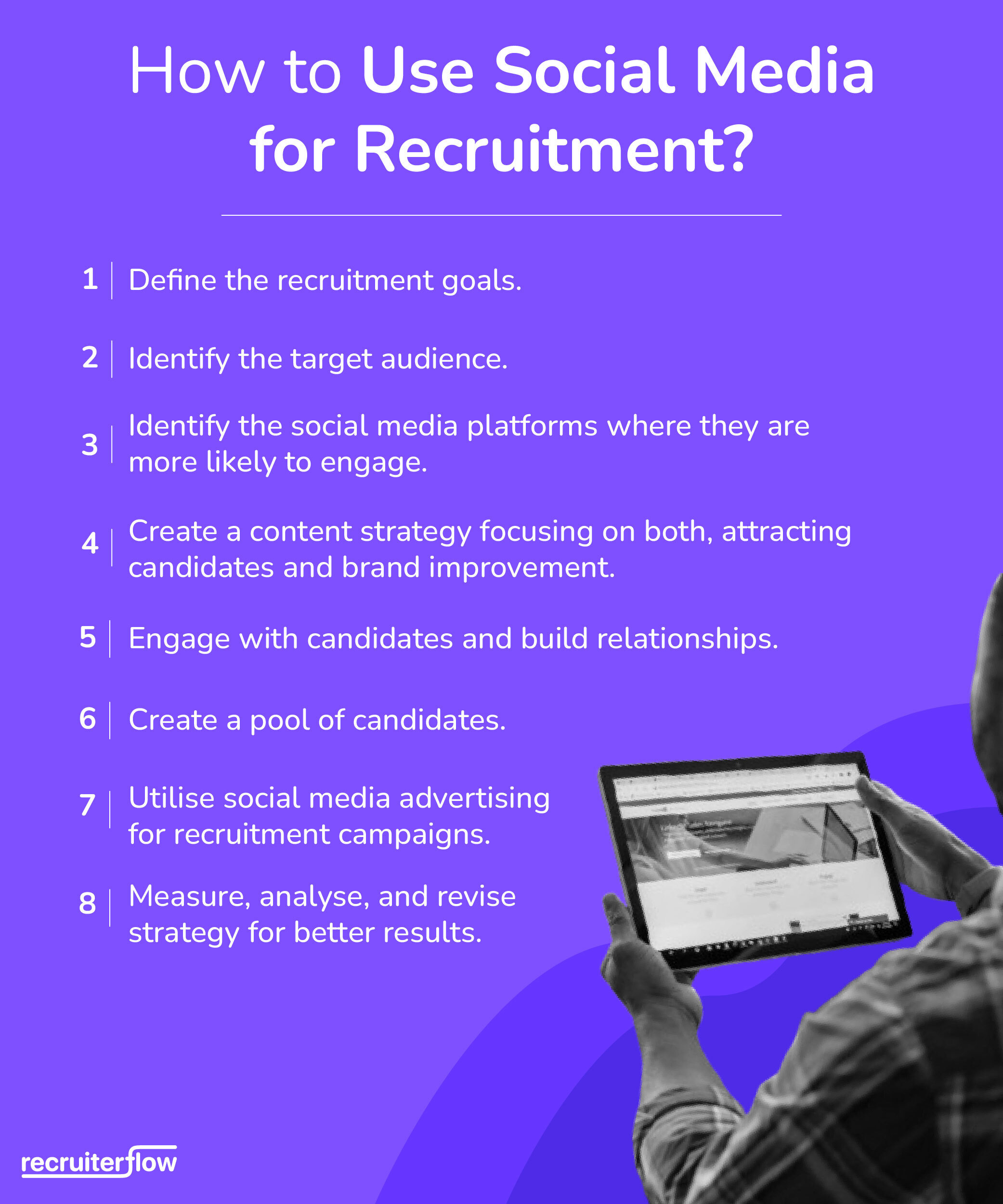
Recruitment businesses that are used to traditional recruitment practices might wonder why social media recruiting has gained so much popularity in recent years. The next section will knock any doubts about ‘whether or not we should use social media as a recruitment tool’ out of the park.
Why has social media emerged as an important force in recruiting?
To understand this, we need to shift our focus on what the workforce thinks about social media and how they interact with it. According to a study in the US, 45% say social media is very important for them in their job search. Here’s a breakdown of how each generation feels about social media when it comes to finding job opportunities.
| Generation | Discovered job opportunities on social media (in %) | Used social media for job search (in %) |
| Boomers (Ages 58-76) | 12 | 7 |
| Gen X (Ages 42-57) | 31 | 24 |
| Millennials (Ages 26-41) | 56 | 48 |
| Gen Z (Ages 18-25) | 62 | 48 |
This study reflects on how the tide is changing and as the majority of the active working professionals shift their preference towards social media, recruitment businesses need to change their approach with it. [Discover our best tips for sourcing candidates using social media]
However, businesses that are not well acquainted with the nuances of social media platforms might face challenges in selecting the right platform. Let’s look at some popular social media platforms and try to understand which works best for what.
Also read our blog on the best social media recruiting tools.
Which social network is most commonly used for external recruiting?
Every social media platform has advantages of its own, and some are better suited for hiring than others. Studies suggest almost 94% of recruiters use social media, and this number is constantly rising. Let’s look at a more detailed breakup of how recruiters use some of the most widely used platforms for hiring.
| Social media platform | Recruiters using it (in %) |
| 90 | |
| X | 47 |
| 11 | |
| 55 | |
| YouTube | 35 |
Let’s start with LinkedIn.
Being the largest professional networking platform in the world, LinkedIn offers the best of both worlds for agencies (a wide reach in a specific niche.) It’s easy to post jobs and kick-start your hiring process. You can also scrape LinkedIn to find great candidates. At the same time, it’s equally easy for candidates to apply for jobs.
Microsoft CEO, Satya Nadella, once said 3 people secure a job via LinkedIn every minute. According to LinkedIn, 40 million people look for jobs every week. Here are some features that make it a great social media recruiting tool:
- Access to a large talent pool
- Advanced search filters
- Find better candidate fit with features like boolean search
- Better job visibility with cost-effective advertising options
- ATS integration available
X (previously known as Twitter)
Recently X announced, that organizations can now promote jobs directly to the timelines of their desired target audience.
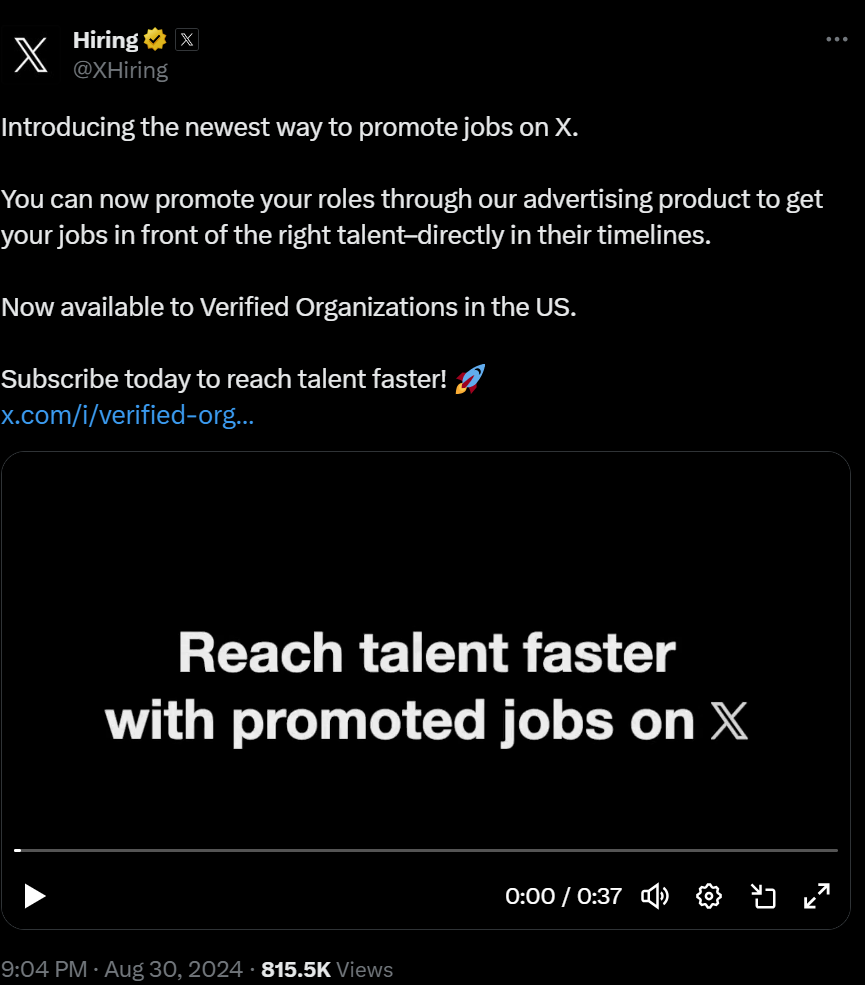
One of the best companies that leverages X for hiring is PepsiCo. They’ve created a page just for hiring, where they share employee stories, achievements, and more. Some of the key features of X are:
- A diverse user base.
- Great to identify culture fit (as it’s a more fun and casual platform compared to LinkedIn.)
- Direct candidate engagement.
- Great platform to run creative recruitment campaigns.
- Cost-effective, easy to share and use.
- Hiring features rolled out for the US.
With over 1 billion people visiting Facebook’s ‘Pages’ every month, businesses in the US are allowed to post jobs and applications directly on Facebook. Niching down is a growth strategy the majority of agencies prefer, and that’s where Facebook comes in as a great source. With Facebook groups, you get access to a large talent pool. Some key features of recruiting from Facebook are:
- Reach active and passive candidates.
- Cost-effective solution to promote jobs.
Instagram is a great social media recruiting tool for reaching a diverse list of candidates. It’s where Gen Z and millennials hang out most, and creating content that resonates with them is a sure-shot way of sparking curiosity and interest in joining hands with you. Its informal nature gives recruiting businesses the creative liberty to test out different strategies. While browsing potential candidates, you may notice some profiles appear as Instagram users, a sign the account is inactive and should be skipped in your outreach. Some key recruitment features:
- A powerful tool for branding.
- Easy to jump on trending reels or audio.
- Cost-effective.
- Geotagging helps reach the target audience more effectively.
YouTube
The second largest search engine in the world is a great option for recruitment. Many leading organisations like IKEA, NZ Post, Wizz Air, Fiverr, and Mercedes Benz rely on YouTube to boost their branding and recruitment process. You can check out the whole list of creative recruitment campaigns in our latest blog. Some key recruiting features include:
- Enhanced job visibility.
- Build employer branding.
- Long-form video allowing agencies to showcase company culture and values
We’ve talked a lot about what makes social media great, but like every coin has two sides to it. Let’s take a look at what challenges recruitment agencies can face when they adopt social media recruiting as a part of their hiring process.
Challenges in Social Media Recruiting
- The candidate’s profile may not be updated. In this case, it can be tough to gauge the quality of the candidate.
- Can create a bias. Not everyone posts on social media with the thought, ‘A recruiter might check this post or comment.’ It can get tough for recruiters to identify suitable candidates or worse, create a hiring bias based on a few posts or comments.
- It can be a time-consuming process to check every potential candidate’s profile manually. In such cases, using an ATS like Recruiterflow that integrates seamlessly with a platform like LinkedIn and allows you to import candidate details with few clicks, can be a huge time saver.
- One bad incident can quickly turn into a PR nightmare. Protecting the brand image is a hassle on social media platforms.
- It takes a lot of effort and knowledge to stand apart on social media. It can also be expensive whether you decide to manage your content marketing in-house or outsource it to an ad agency.
- Every platform needs a different recruitment strategy.
So, recruitment businesses that are somewhat new to this social media game, might wonder– how do businesses get successful in this complex task? Here are some creative social media recruiting examples from which to draw some inspiration.
Best social media recruiting examples
1. HP
HP showed its commitment to DEI with a complete set of recruitment initiatives for a campaign called, ‘Reinvent Mindsets.’ This is a great example of using creative storytelling backed with strong audio-visuals that speak one thing clearly– anybody can do anything they want.
2. me&u (formerly Mr. Yum)
After successfully raising $89 million in funds, me&u(back then Mr Yum) instead of just using the traditional hiring methods, took things to a whole new level with a hiring video that’s engaging, gives a gist of things, and is short & sweet.
3. Bud Light
Getting the job description right is important and when you’re hiring for a ‘Chief Meme Officer’, Bud Light had to bring in their A-game in the job ad– and they did just that. This example highlights the importance of how every job post must have a blend of what you’re looking for.
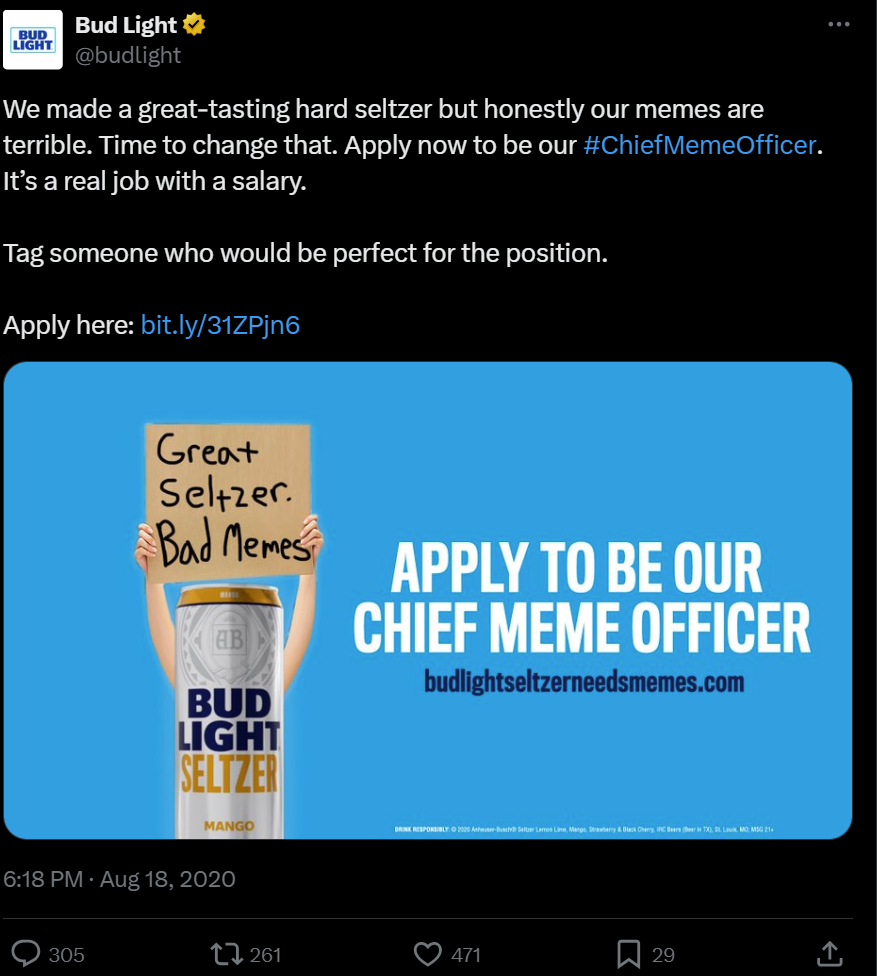
4. Campbell
How to shed some light on the company values, ensure the messaging is in line with the visuals, and end with a powerful CTA in one hiring post? The Campbell Soup Company illustrates it perfectly with this hiring post.
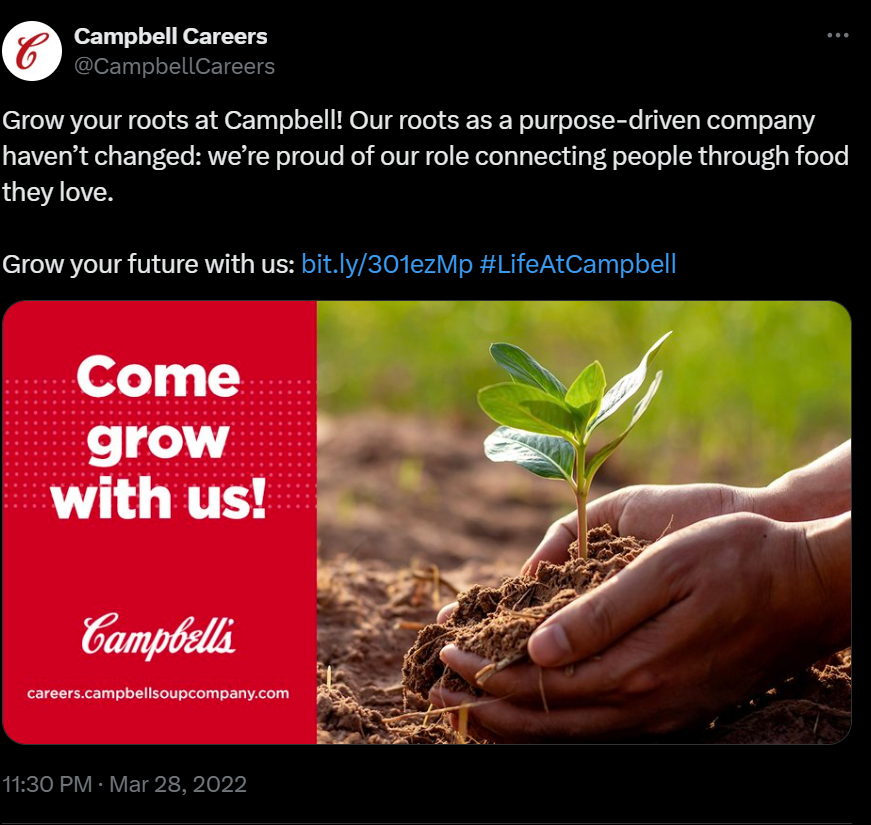
5. Cross Country Healthcare
Another great example of showcasing diversity in the workforce is Cross Country Healthcare’s social media hiring post. Notice how they’ve used witty writing to increase the impact.
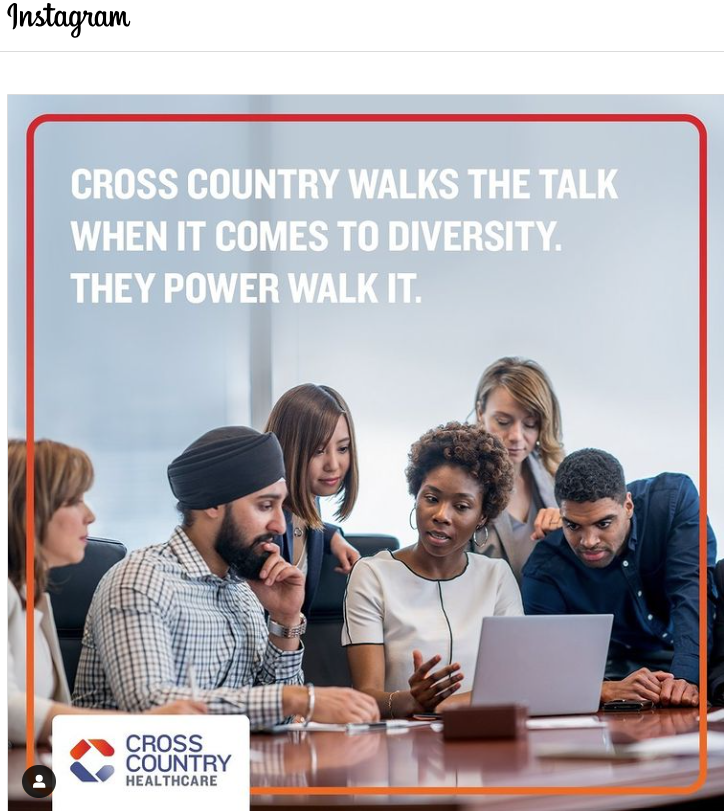
Recruiting candidates in a hyper-competitive market is challenging. Using social media as a recruiting tool helps businesses find active candidates and nurture passive candidates. This can help agencies create a more dynamic, engaging, and personalized recruitment experience. Social media recruiting allows faster and more effective talent acquisition. Ready to enhance your social media game?
Book a free demo.
Abhishek holds 7+ years of experience in helping companies rank for over 1,000 commercial keywords with a data-driven approach. As the SEO lead at Recruiterflow, he drives strategies that boost organic visibility and ensure competitive growth. Outside of work, Abhishek is a dedicated father of two, finding balance between his passion for SEO and family life.


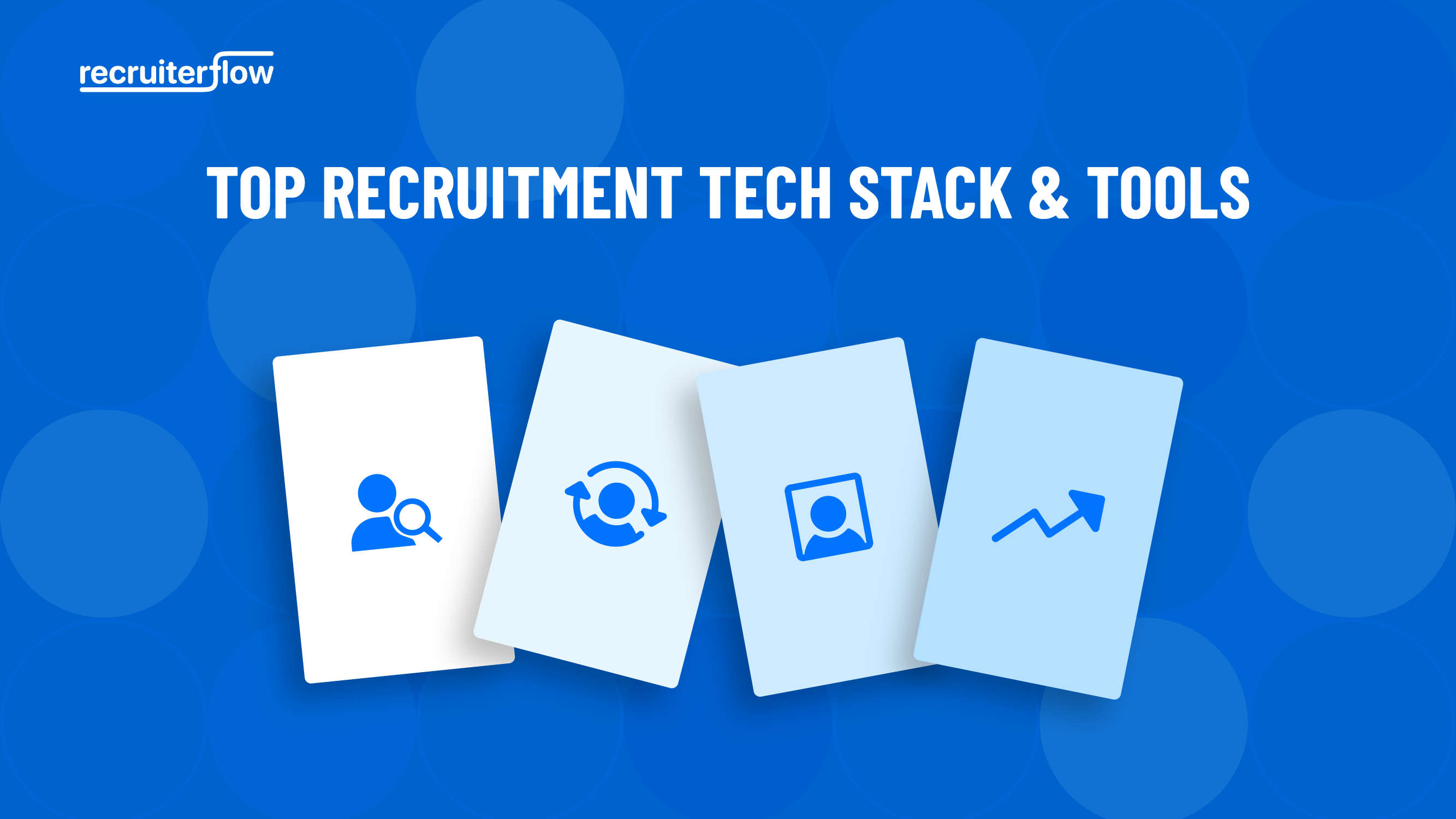

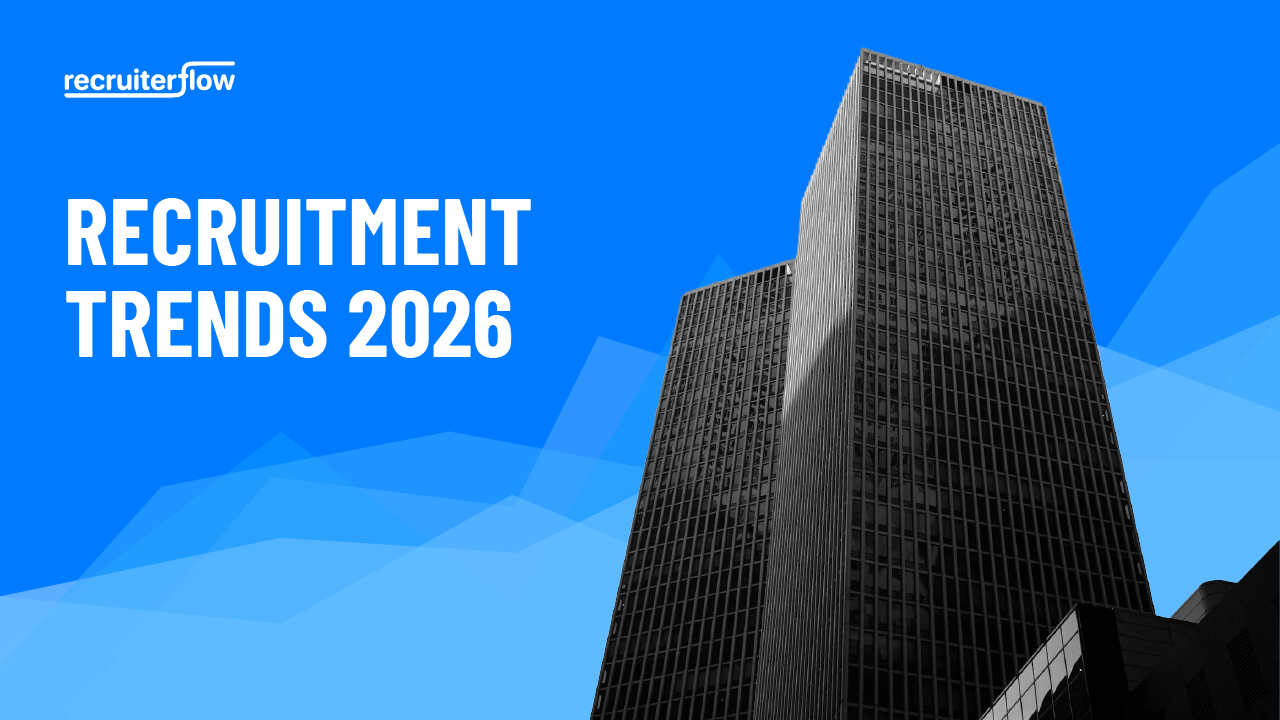

Abhishek Sharma